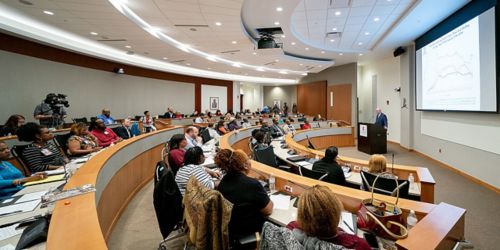St. Jude Family of Websites
Explore our cutting edge research, world-class patient care, career opportunities and more.
St. Jude Children's Research Hospital Home

- Fundraising
St. Jude Family of Websites
Explore our cutting edge research, world-class patient care, career opportunities and more.
St. Jude Children's Research Hospital Home

- Fundraising
Ending the HIV epidemic: A national plan to reduce HIV infections

The goal of the Ending the HIV Epidemic plan is to reduce the number of new infections by 90 percent in the next 10 years.
To end the HIV epidemic, it’s imperative to prevent new infections, as well as to make sure those who are HIV-positive receive ongoing retroviral therapy. It is estimated more than 7,500 people are living with HIV or AIDS in Shelby County, Tenn.
Those people, and those at-risk for becoming infected with the HIV virus, are the focus of the Ending the HIV Epidemic: A Plan for America initiative. The effort is being coordinated by the U.S. Department of Health and Human Services (HHS). Locally, the program is being led by St. Jude Children’s Research Hospital. The goal is to reduce new infections by 90% in the next 10 years. Read how St. Jude is setting a goal of having zero new HIV cases in Memphis by 2030 in "New HIV Cases: Operation Zero."
A plan to reduce HIV rates
St. Jude recently hosted an Ending the HIV Epidemic meeting to not only discuss the challenges and issues that prevent patients from receiving regular care, but to share successful innovative approaches and discuss potential solutions to help reduce HIV rates.
An estimated 66% of people living with HIV in Shelby County have experienced viral suppression thanks to antiretroviral therapy. This doesn’t mean patients are cured, but it does mean the virus is nearly undetectable and there is little risk of being transmitted to others. But with viral suppression, it becomes more important than ever for those infected to continue regular therapy.
Solutions to improve HIV treatment adherence
Continuation of regular therapy is imperative for a community like Memphis, which has incident rates three times higher than the national average in people between 15 and 24. A majority of people infected fall below the poverty line, so they may not be getting the care they need in order to live a long, healthy life with the disease.
One of the challenges faced by the Ending the HIV Epidemic plan is how to address perceived and real barriers that may prevent these patients from receiving regular treatment.
More than $291 million in federal funding has been requested in the HHS FY2020 budget to begin carrying out the multi-year initiative. For patients in a high-poverty city like Memphis, how and where those funds are distributed could mean the difference between patients being given the care they need and possibly falling through the cracks.
Eugene McCray, MD, director of the Division of HIV/AIDS Prevention, U.S. Centers for Disease Control and Prevention, along with officials from the federal Health Resources & Services Administration and Department of HHS participated in the meeting.
McCray points out that a key part of Ending the HIV Epidemic is reaching those who have not been fully included in local HIV prevention and care programs.
“This initiative will provide the hardest hit communities — including Shelby County — with additional expertise, technology and resources required to address the HIV epidemic in their communities,” he said. “We can’t end the epidemic unless we work with front-line community organizations to reach those who aren’t being reached.”
McCray said CDC and HHS emphasize the importance of local community engagement. That means collaboration with local health departments, community and faith-based organizations, as well as federally qualified health centers, hospitals, local education agencies, academic institutions and the private sector.
“This aspect of the planning process is critical for successfully reaching people in communities experiencing health disparities and have either not had access to prevention and care programs, or who have not felt included as part of the intended audience for such programs,” McCray said.
Reducing the discrimination of AIDS
Another barrier for patients when it comes to continuation of treatment is prejudice or discrimination some patients still face. The Centers for Disease Control collaborates with other agencies on a federal level to address those issues.
The common message of how to work with people with HIV is one of understanding, compassion, and most importantly, letting them know they’re not alone and that with care, their disease isn’t necessarily a death sentence. One of the best ways to ensure patients are being treated with respect is to hire more HIV-positive staff in organizations that work with HIV/AIDS patients.
“Understanding the populations affected by HIV provides the basis for setting priorities, identifying appropriate interventions and services, allocating HIV prevention and care resources, planning programs, and evaluating programs and policies,” McCray said. “Also, to improve engagement in care, it is critical to involve the ‘not in care’ population through planning, design and implementation of services.”






